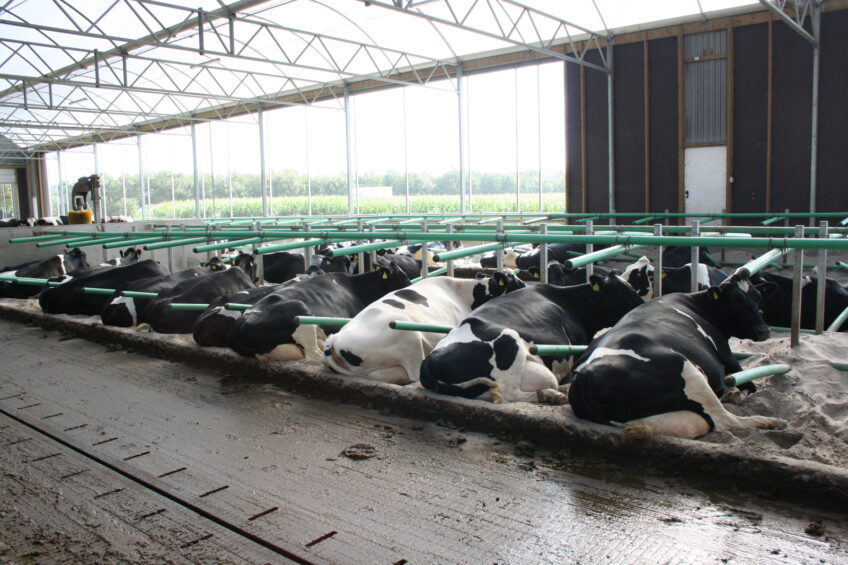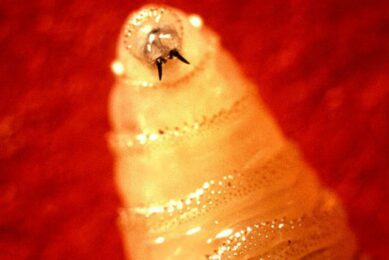Optimal conditions for modern day dairy cows

Intensive dairy farming demands very much from modern day dairy cows. Genetic improvement resulted in higher yield capacity and on average larger cows. For efficiency purposes they are kept indoors year round. Helping the modern day dairy cow to be able to express its genetic potential is the challenge, creating optimal conditions fitting the cows natural behavior the way to go.
Picture a medium size herd of dairy cows grazing in a luscious pasture on a sunny day with an ancient tree here and there providing shade. For marketing purposes one couldn’t find a better scene to sell more all natural, healthy milk or dairy produce. That said, for cows and farmers it is not the best management practice on the majority of days during the year. On rainy or cold and windy days the herd seeks shelter instead of grazing, on warm summer days they try to stay in the shade as much as possible and burn energy trying to cope with the heat. Left or right, production is far from optimal. Unsurprisingly more and more farmers choose to keep their herd indoors, this way they are in control of the environment and have the possibility to optimise management to ensure feed intake and milk yield.
Certain drawbacks
Keeping the cows indoors and maintaining production is easier said than done. Old style winter barns are not suitable most of the time. Newer barn designs incorporate the need for clean air, light and space to move around. Dairy Global visited Tom Scholtens ‘Serre barn’ in Denmark with plenty of room for the 300 cows it houses. “It’s the only barn of this type in Denmark,” Scholtens says proudly. Apart from the cost efficient construction farmer Scholtens especially likes the indoor micro climate: “it’s like being in the open air, without the drawbacks of sunburn, rain and wind.”
New barn designs rule out the unpredictable and sometimes negative effects of grazing and limit the negative effects of all year housing as well. However, the combination of intensifying production and fully housed herds has certain drawbacks. Scholtens adds: “We all know that the mean age of cows could be higher, leg problems could be lower and cows could be happier and produce even more milk.” According to the farmer the meaning of life of every colleague should be to chase after every possibility to work on the cows’ welfare and thus profitability.
Cow welfare
Scholtens’ search for improving the life of his cows brought him to Tommy Wollesen of the Cow Welfare company. Wollesen’s theory is short and simple: “Besides walking to and from the milking parlour a cow should be eating or resting. A relaxed cow will be healthier, produce more, live longer and result in relaxed farmers as well.” He introduced Scholtens to the so called ‘Green Stalls’, a flexible plastic cubicle system that gets rid of the shortcomings of the traditional steel cubicles. Wollesen describes his quest which led to the improvements: “It started with observing. Seeing up to 40% of the cows standing, lingering with their front legs in the boxes, digging up the sand and not getting down. Even when the animals came to rest in the traditional cubicle not everything was okay. A lot of cows, especially the older cows of grand stature, didn’t look comfortable to me. On more than one occasion they lie jammed against the steel and were prone to stand up again after a relatively short period of time.” According to the designer of the plastic cubicles this shortened the resting time of the cows: “Ideally a cow should lie down as much as possible, because that improves blood flow to the udder.”
Looking at the natural movement and requirements of the cow Wollesen came up with the idea for the Green Stalls. The system breaks tradition, without taking up more precious box space in the barn. Farmer Scholtens: “The dimensions of the boxes are the same as I was used to, but with the advantage that the bars in between the individual boxes are flexible. It’s impossible for the cows to get stuck or get hurt. Bigger cows simply take a few centimetres extra by pushing the bar aside.”
Resting behaviour
On Scholtens farm as on other Danish farms with the Green Stalls the animals seem stress free. Wherever one goes, the boxes are full of resting cows. Wollesen: “Besides the flexible divider bars we moved the neck rail five centimetres down and 10 centimetres further to the back compared with traditional cubicles. The combination of matters ensures that the cows rest as much as possible.” Monitoring results showed that it takes only between 29 and 34 seconds from the first hoof in the box until a cow is lying down correctly. Row after row the cows are all resting with their behind nicely at the edge of the box, keeping manure and urine out of the sand box as much as possible.
The farmers are really fond of the cubicles. “The cows are spotless and relaxed. Because they are off their feet for prolonged times, 10 to 12 hours per day, hoof and leg quality is better than I have seen ever before. The fact that the herd is so relaxed makes it very easy to spot cows in heat. If you have experienced your herd in a barn like this, you know this is the way it is supposed to be.”
Results make the difference
Apart from the nice sight of relaxed cows, the results make the difference. The Green Stall cost about 10% more than traditional steel ones (depending on local steel prices), but a return on the extra investment can be possible within three months. Scholtens saw an increase of five litres of milk per cow per day to a total of 12,000 litres per cow per year and a cell count never over 100,000, but that includes the move from an old barn to the new Serre barn. On average supplier Wollesen sees an increase of 2.2 litres per cow per day with 150,000 cubicles delivered. “But there is more. On average the animals live 8% longer in our system. Per 100 animals that amounts to eight years extra milk production and eight extra calves born.” That is where the real profit is.
Join 13,000+ subscribers
Subscribe to our newsletter to stay updated about all the need-to-know content in the dairy sector, two times a week.













